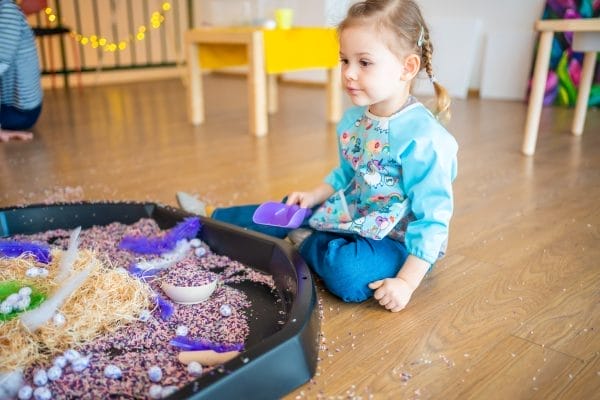Sensory Development: Understanding How Children Learn to Use Their Five Senses
The term “sensory development” refers to the gradual process of children learning to use their senses—sight, sound, taste, touch, and smell—to understand and navigate the world around them. It’s a complex journey that begins even before a child is born and continues through infancy and into early childhood. Sensory development is a critical aspect of overall growth, as it lays the foundation for learning more complex skills, from recognizing a parent’s face to grasping a toy or speaking a first word.

What Is Sensory Development?
![]()
Sensory development encompasses the refinement of the five basic senses, along with two additional senses often overlooked: the vestibular sense, which contributes to balance and spatial orientation, and proprioception, which informs about body position and movement. This development is essential because it helps children learn how to respond to their environment and, importantly, to develop cognitive, social, and physical skills.
Newborn Sensory Development
![]()
Even as newborns, babies are already equipped with certain sensory abilities. They can hear sounds, especially higher-pitched voices, which is why they may respond more to a woman’s voice. While their vision is still blurry, they can see contrasts and are drawn to faces. They have a developed sense of taste and can differentiate between sweet and bitter. Their sense of smell is keen, and they can recognize the scent of their mother. The sense of touch is also highly developed, with newborns responding to warmth, cold, and pain.
Sensory Development Milestones in Newborns
- Hearing: Newborns can startle or change their sucking patterns in response to sounds.
- Vision: They focus on objects 8 to 10 inches from their faces – the approximate distance to a parent’s face when held.
- Taste and Smell: They show preferences for sweet tastes and can recognize their mother’s milk by smell.
- Touch: Newborns can feel pain and respond to touch, often finding comfort in being held or swaddled.
Sensory Development in Infants
![]()
As infants grow, their senses become more refined. By the age of 6 months, a baby’s vision is nearly that of an adult’s in terms of focusing ability, color vision, and depth perception. Babies will turn their heads toward sounds and start to enjoy rhythmic patterns in music or speech. They also begin to explore objects with their hands and mouth, which is an important part of sensory development.
Key Sensory Milestones in Infants
- 3-4 Months: Infants will start to follow moving objects with their eyes and reach for things.
- 4-6 Months: They will respond to affection and start to show enjoyment at being tickled or hugged.
- 6-9 Months: Babies begin to understand object permanence, meaning they know objects exist even when out of sight.
- 9-12 Months: They will start to use their fingers to point or poke, exploring textures and shapes more intricately.
The Role of Sensory Development Toys
![]()
Sensory development toys are designed to stimulate a child’s senses and support the development of cognitive skills. These toys can range from simple rattles to more complex activity centers. The key is that they engage one or more senses in a way that encourages exploration and learning.
Examples of Sensory Development Toys
- Rattles and Musical Toys: These can help with auditory development and the understanding of cause and effect.
- High-Contrast Books and Mobiles: Visually stimulating toys help with visual tracking and focus.
- Textured Balls and Blocks: Toys with different textures support tactile exploration and fine motor skills.
- Activity Mats: These often feature a variety of textures, colors, and sounds to engage multiple senses at once.
Activities for Sensory Development
![]()
Structured playtime can be incredibly beneficial for sensory development in infants and children. Parents and caregivers can engage in a variety of activities that promote the growth of sensory pathways and encourage the development of motor skills, cognitive skills, and language.
Ideas for Sensory Activities
- Messy Play: Activities like finger painting or playing with food can help children explore textures.
- Music and Dance: Listening to different types of music and moving to the beat enhances auditory and vestibular development.
- Outdoor Exploration: Being outside exposes children to a variety of sights, sounds, and smells, enriching their sensory experience.
- Reading and Storytelling: Looking at books with colorful pictures and listening to stories stimulates vision and hearing while enhancing language skills.
The Importance of a Sensory-Rich Environment
![]()
Creating a sensory-rich environment means providing opportunities for children to actively use their senses as they explore their world. Each new experience that a child encounters is an invitation to learn. This environment can be as simple as a room with various textures to touch, music of different genres to listen to, and objects of different shapes and colors to see.
Characteristics of a Sensory-Rich Environment
- Safe and comfortable space that encourages exploration
- Variety of textures, patterns, and colors
- Different sounds and musical instruments
- Accessible materials for messy play (e.g., water, sand, clay)
Supporting Sensory Development at Home
![]()
Parents and caregivers can support sensory development at home by being proactive in offering diverse experiences. This can include reading books with bright pictures, playing different types of music, or simply going for a walk and talking about what you see and hear. Remember that every child develops at their own pace, and while one child may enjoy a particular sensory activity, another may not respond in the same way.
Tips for Encouraging Sensory Development
- Provide a range of activities that stimulate all the senses
- Allow children to explore and play without too much direction
- Be attentive to how your child reacts to different sensory experiences
- Encourage play that involves movement to develop balance and coordination
Frequently Asked Questions
![]()
Why is sensory development important in early childhood?
Sensory development is crucial because it helps children learn about their environment. It is the foundation for learning complex skills, as children use their senses to grasp concepts like language, social cues, and problem-solving.
How can I tell if my baby’s sensory development is on track?
You can generally tell if your baby’s sensory development is on track by observing their reactions to different stimuli. For example, they should startle at loud noises, follow objects with their eyes, and turn their head towards familiar smells or sounds. If you’re concerned, talk to a pediatrician.
When do babies start to develop their senses?
Babies begin to develop their senses while they’re still in the womb. Hearing develops around the second trimester, and by the time they are born, babies can see, hear, taste, smell, and feel.
How does sensory play help with sensory development?
Sensory play involves activities that stimulate a child’s senses. It helps with sensory development by encouraging children to use their senses actively, which enhances cognitive growth, fine and gross motor skills, problem-solving skills, and social interaction.
Can too much sensory stimulation be harmful?
Yes, too much sensory stimulation can be overwhelming for children, especially infants. Overstimulation can lead to irritability, trouble sleeping, and difficulty focusing. It’s important to watch for cues that a child needs a break and provide a quiet environment to relax.
What are some signs of sensory processing issues?
Signs of sensory processing issues may include overreacting to touch, sounds, or lights, being either extremely active or very passive, clumsiness, difficulty with tasks that require fine motor skills, and problems with eating or sleeping.
How do I support a child with sensory processing issues?
You can support a child with sensory processing issues by being patient and understanding. Create a structured routine, minimize sensory overload, and work with an occupational therapist for strategies tailored to the child’s needs.
What role does nutrition play in sensory development?
Good nutrition is vital for brain development, which directly impacts sensory development. Certain nutrients are particularly important, such as omega-3 fatty acids, iron, and vitamins A, C, and E.
How can I encourage my child’s sensory development at home?
Encourage sensory development by providing a variety of activities that stimulate all the senses. This can include playing with playdough, listening to music, reading books, spending time outdoors, and offering a range of foods with different tastes and textures.
Conclusion
![]()
Sensory development is a foundational element of a child’s growth, affecting all other areas of development. Understanding what sensory development is and how it unfolds enables parents and caregivers to better support children on their journey.
From newborn sensory development to the introduction of sensory development toys and activities for sensory development, each step plays a crucial role in helping children engage with the world around them. By fostering a sensory-rich environment and engaging in a variety of sensory activities, caregivers can contribute to a child’s ability to learn, play, and interact with others effectively.
In conclusion, sensory development is more than just touching, seeing, or hearing—it’s about making connections and understanding the world. By nurturing these skills from a young age, we lay the groundwork for a lifetime of learning and discovery.




